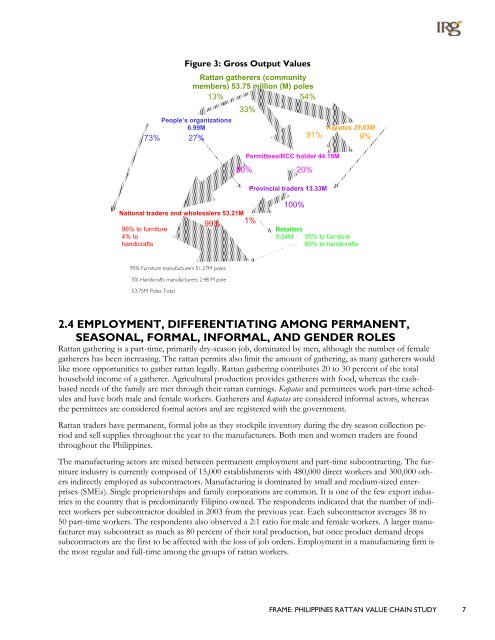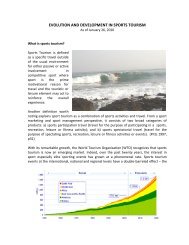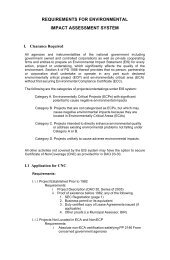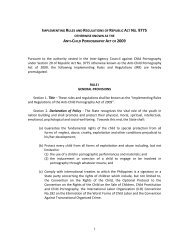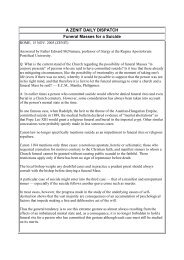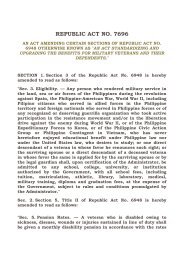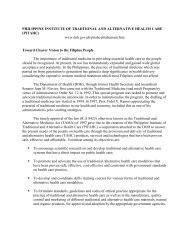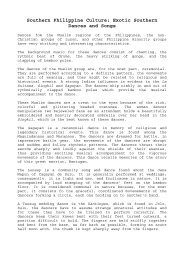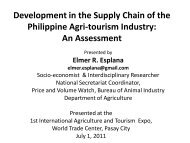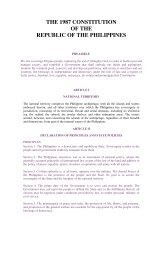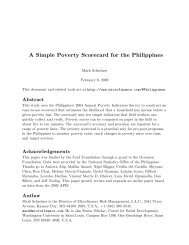PHILIPPINES RATTAN VALUE CHAIN STUDY - About the Philippines
PHILIPPINES RATTAN VALUE CHAIN STUDY - About the Philippines
PHILIPPINES RATTAN VALUE CHAIN STUDY - About the Philippines
You also want an ePaper? Increase the reach of your titles
YUMPU automatically turns print PDFs into web optimized ePapers that Google loves.
Figure 3: Gross Output Values<br />
Rattan ga<strong>the</strong>rers (community<br />
members) 53.75 million (M) poles<br />
13%<br />
54%<br />
33%<br />
People’s organizations<br />
6.99M<br />
Kapatas 29.03M<br />
73% 27%<br />
91% 9%<br />
Permittees/RCC holder 44.15M<br />
80% 20%<br />
Provincial traders 13.33M<br />
National traders and wholesalers 53.21M<br />
96% to furniture<br />
4% to<br />
handicrafts<br />
99% 1%<br />
100%<br />
Retailers<br />
0.54M<br />
35% to furniture<br />
65% to handicrafts<br />
95% Furniture manufacturers 51.27M poles<br />
5% Handicrafts manufacturers 2.48 M pole<br />
53.75M Poles Total<br />
2.4 EMPLOYMENT, DIFFERENTIATING AMONG PERMANENT,<br />
SEASONAL, FORMAL, INFORMAL, AND GENDER ROLES<br />
Rattan ga<strong>the</strong>ring is a part-time, primarily dry-season job, dominated by men, although <strong>the</strong> number of female<br />
ga<strong>the</strong>rers has been increasing. The rattan permits also limit <strong>the</strong> amount of ga<strong>the</strong>ring, as many ga<strong>the</strong>rers would<br />
like more opportunities to ga<strong>the</strong>r rattan legally. Rattan ga<strong>the</strong>ring contributes 20 to 30 percent of <strong>the</strong> total<br />
household income of a ga<strong>the</strong>rer. Agricultural production provides ga<strong>the</strong>rers with food, whereas <strong>the</strong> cashbased<br />
needs of <strong>the</strong> family are met through <strong>the</strong>ir rattan earnings. Kapatas and permittees work part-time schedules<br />
and have both male and female workers. Ga<strong>the</strong>rers and kapatas are considered informal actors, whereas<br />
<strong>the</strong> permittees are considered formal actors and are registered with <strong>the</strong> government.<br />
Rattan traders have permanent, formal jobs as <strong>the</strong>y stockpile inventory during <strong>the</strong> dry season collection period<br />
and sell supplies throughout <strong>the</strong> year to <strong>the</strong> manufacturers. Both men and women traders are found<br />
throughout <strong>the</strong> <strong>Philippines</strong>.<br />
The manufacturing actors are mixed between permanent employment and part-time subcontracting. The furniture<br />
industry is currently composed of 15,000 establishments with 480,000 direct workers and 300,000 o<strong>the</strong>rs<br />
indirectly employed as subcontractors. Manufacturing is dominated by small and medium-sized enterprises<br />
(SMEs). Single proprietorships and family corporations are common. It is one of <strong>the</strong> few export industries<br />
in <strong>the</strong> country that is predominantly Filipino owned. The respondents indicated that <strong>the</strong> number of indirect<br />
workers per subcontractor doubled in 2003 from <strong>the</strong> previous year. Each subcontractor averages 38 to<br />
50 part-time workers. The respondents also observed a 2:1 ratio for male and female workers. A larger manufacturer<br />
may subcontract as much as 80 percent of <strong>the</strong>ir total production, but once product demand drops<br />
subcontractors are <strong>the</strong> first to be affected with <strong>the</strong> loss of job orders. Employment in a manufacturing firm is<br />
<strong>the</strong> most regular and full-time among <strong>the</strong> groups of rattan workers.<br />
FRAME: <strong>PHILIPPINES</strong> <strong>RATTAN</strong> <strong>VALUE</strong> <strong>CHAIN</strong> <strong>STUDY</strong> 7


